|
Dr. Hoffer's
Travel Site
This site was last updated
01/17/13
|
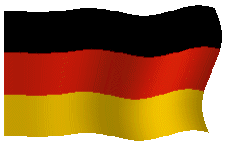

 GERM07
#11
DRESDEN city
GERM07
#11
DRESDEN city




Sunday
June 17, 2007

We are in the heart of Europe, on the mid-eastern edge of Germany and in the heart
of Saxony, in its beautiful and historic capitol of
Dresden (Official
Site.) After its WWII destruction it was slowly restored during the Communist era and lovingly
restored after its freedom in 1989. This is a city not to be missed on any
visit to Germany. I loved it.
%20(2).jpg)
Dresden (city flag
 left,
coat of arms right) is
the capital city of the
Free State of Saxony. It has an area of 127 mi2 (329 Km2)
and a population of 529,781 with a population density of 4,173/mi2
(1,611 /Km2.) It is
situated in a valley on the
Elbe River, near
the Czech
left,
coat of arms right) is
the capital city of the
Free State of Saxony. It has an area of 127 mi2 (329 Km2)
and a population of 529,781 with a population density of 4,173/mi2
(1,611 /Km2.) It is
situated in a valley on the
Elbe River, near
the Czech
 border.
The Dresden population area is part of the
Saxon Triangle metro area with 2.4 million inhabitants. Dresden
has a long history as the capital and royal residence for
the Electors and Kings of Saxony, who for
centuries furnished the city with cultural and artistic splendor. The city
was known as the Jewel Box, because of its baroque and rococo city center as
well as to its housing one of the largest jewel collections in Europe.
It was the southern part of East Germany (GDR,
border.
The Dresden population area is part of the
Saxon Triangle metro area with 2.4 million inhabitants. Dresden
has a long history as the capital and royal residence for
the Electors and Kings of Saxony, who for
centuries furnished the city with cultural and artistic splendor. The city
was known as the Jewel Box, because of its baroque and rococo city center as
well as to its housing one of the largest jewel collections in Europe.
It was the southern part of East Germany (GDR,
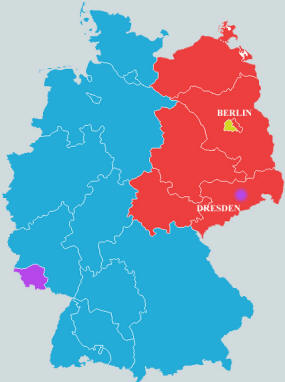 red in map right) but, since the German reunification in 1990, Dresden has regained importance
as one of the cultural, educational, political and economic centers of Germany
and Europe today.
red in map right) but, since the German reunification in 1990, Dresden has regained importance
as one of the cultural, educational, political and economic centers of Germany
and Europe today.
Although Dresden is a relatively recent city of Slavic origin, the area had been
settled in the Neolithic era by Linear Pottery culture tribes around 7500 BC.
Its founding and early growth is due to the
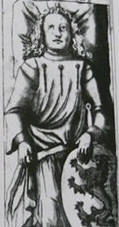
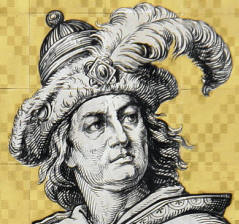 eastward expansion of the Germanic
peoples, mining in the nearby Ore Mountains and the establishment of the
Margravate of Meissen. Its name
etymologically derives from the
Old Sorbian Drežďany, meaning "people of the forest." By the late 12th
Century, the Slavic settlement had
developed on the southern bank and another settlement on the northern
bank. It was known as Antiqua Dresdin since 1350 and later as Altendresden.
Dresden became a city in 1206 and recently celebrated its
eastward expansion of the Germanic
peoples, mining in the nearby Ore Mountains and the establishment of the
Margravate of Meissen. Its name
etymologically derives from the
Old Sorbian Drežďany, meaning "people of the forest." By the late 12th
Century, the Slavic settlement had
developed on the southern bank and another settlement on the northern
bank. It was known as Antiqua Dresdin since 1350 and later as Altendresden.
Dresden became a city in 1206 and recently celebrated its 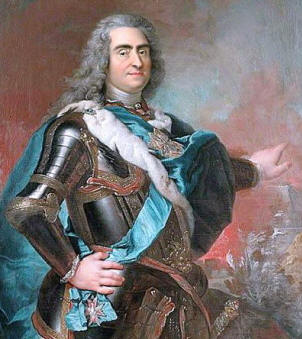 800th birthday in
2006.
800th birthday in
2006.
Dietrich
(Theodoric I, 1162–1221, above left) was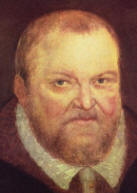 the
Margrave of Meissen and chose Dresden as his interim residence in 1206.
After 1270, Dresden became the capital of the margravate. It was restored
to the Saxon Wettin dynasty
around 1319. From 1485, it was the seat of the dukes of Saxony, and from
1547, the Electors as well. The
ruler of Saxony, Frederick
Augustus I (1526-1586) (left, by Cranach Younger) was named the first Saxony
Elector to the Holy Roman Emperor in 1553.
the
Margrave of Meissen and chose Dresden as his interim residence in 1206.
After 1270, Dresden became the capital of the margravate. It was restored
to the Saxon Wettin dynasty
around 1319. From 1485, it was the seat of the dukes of Saxony, and from
1547, the Electors as well. The
ruler of Saxony, Frederick
Augustus I (1526-1586) (left, by Cranach Younger) was named the first Saxony
Elector to the Holy Roman Emperor in 1553.
King August II the Strong (1670-1733) (right) became King August of
Poland. He converted to Catholicism to accede to the Polish throne but
Saxony was totally Protestant and this did become a problem. He gathered many of the best musicians, architects and painters
from all over Europe to Dresden. His reign marked the beginning of
Dresden's emergence as a leading European city for technology and art.
Dresden suffered heavy destruction in the
Seven Years' War (1756-1763,) and following its capture by Prussian forces, its
subsequent re-capture, and a failed Prussian siege in 1760. Below left is
a depiction of how the city looked in 1521 with its moat and fortified walls.
Below right is a depiction of its appearance in 1550.
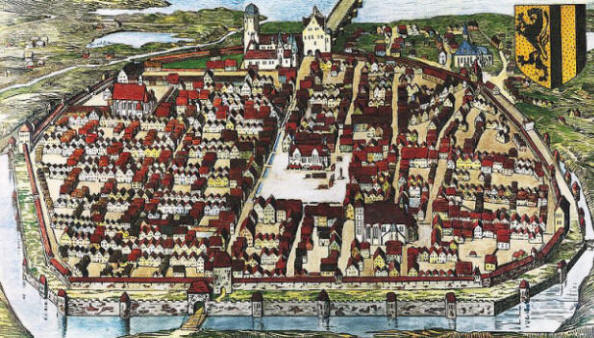
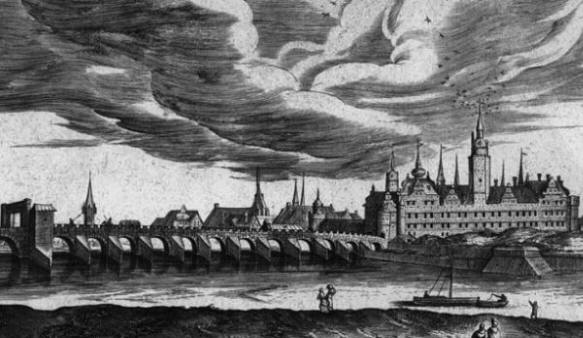
Between 1806 and 1918 the city was the capital of the Kingdom of Saxony (which
was a part of the German Empire since 1871.) During the Napoleonic Wars,
the French Emperor conquered Saxony and he made Dresden a base of operations, winning there the famous
Battle of Dresden in August 1813.
That conquest was short-lived, however. Dresden was later a center of the
German
Revolutions in 1848 with the
May Uprising
in 1849. You can read all about it by clicking the links.
Below left is a map depiction of the city in 1750 and on the right is the
Zwinger Palace in 1896.
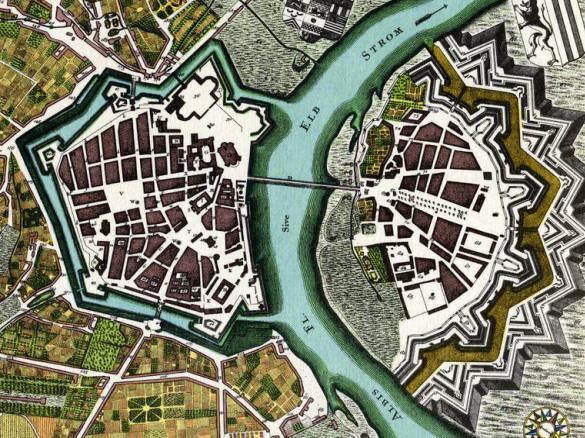
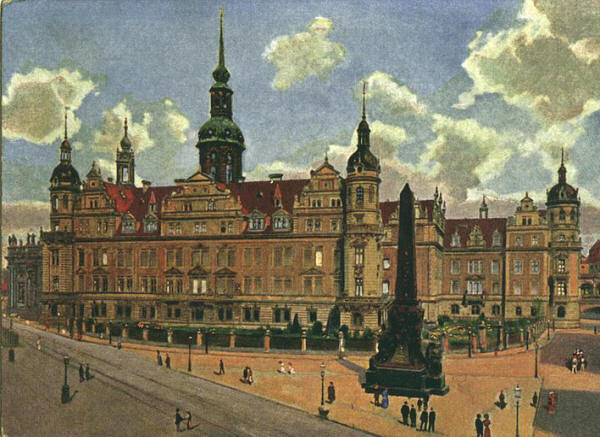
Below are beautiful old stock photos of how Dresden looked circa
1890-1900. Left is the Augustus Bridge crossing the Elbe with the
Frauenkirche (Protestant) on the left and the Hofkirche (Catholic) on the right.
Right is the Zwinger Palace and its gardens.
%20(2).jpg)
.jpg)
During the 19th Century, the city became a major center of economy, including
automobile manufacturing, food processing, banking and the manufacture of
medical equipment. In the early 20th Century Dresden was particularly well
known for its camera works and its cigarette factories. It is interesting to note that Dresden inventors came
up with the first European porcelain (Johann
Friedrich Böttger (below left) in 1708,) the first toothpaste (Chlorodont in
1900) and the first filtered cigarette in 1934.


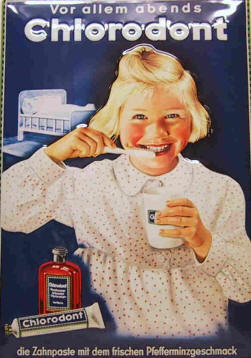

Now to the bad history of Dresden, which cannot be ignored. The
Bombing of Dresden was an attack on the city that took place in the final
months of WW II. In four raids between February 13-15, 1945, 722 heavy
bombers of the British Royal Air Force and 527 of the U.S. Army Air Forces dropped more than 3,900 tons of high-explosive bombs and
incendiary devices on the city. The resulting firestorm destroyed 15 mi2
(39 Km2) of the city center. By early morning on February 14th
(Ash Wednesday,) the center of the city, including its Altstadt, was engulfed in
a firestorm, with temperatures peaking at over 2700 °F (1500 °C.) Below is
what the central city looked like after the fires died out.
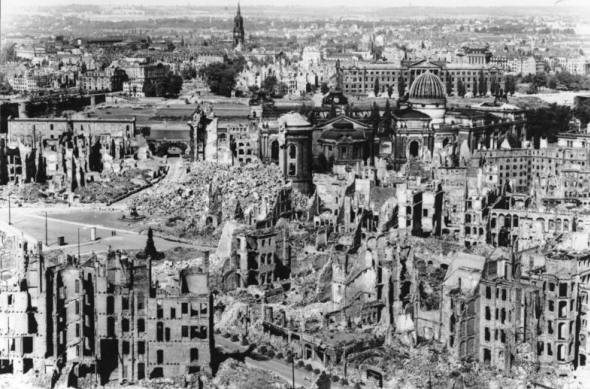
.jpg)
From 22-25,000 people were killed. Of that, 6,865 were cremated on the Altmarkt
square (below left) because there were not enough people to bury them.
Below right is a woman victim of the bombing conflagration. It must have
been horrific. Post-war discussion of whether or not the attacks were
justified has led to the bombing becoming one of the moral controversies of WWII. You can read about the two sides of the story by clicking the link
above. As would be expected, it is still something on the minds of Dresden
residents today.
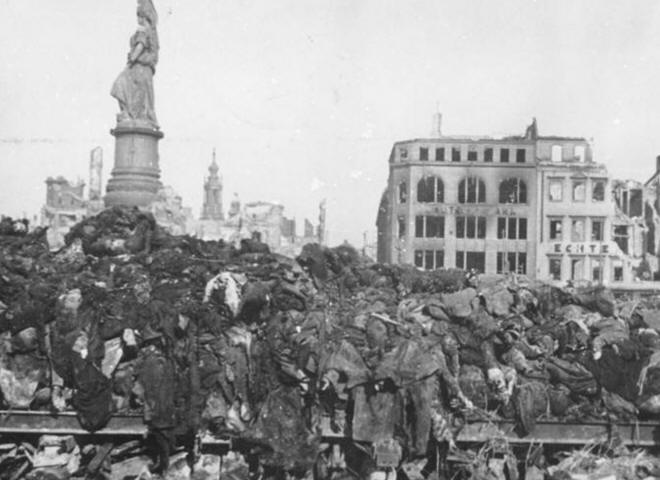
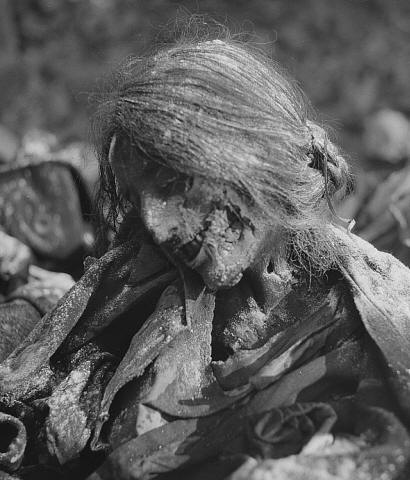
Below is a map of the central city at the bend in the Elbe River with notations
of important things to see and museums.
.png)
Below is a fairly complete list of everything worth seeing as well as the museums in Dresden
in case you might be tempted to visit. Just zoom past it if not of interest.
There are stock photos of most of the important sights.
One could print out the following
section and use it as a guide for touring Dresden.
-
Frauenkirche.
Georg-Treu-Platz 3,
 +49-3-516-560-6100.
The original Church
of Our Lady was
completely destroyed
during WWII. It was
totally
reconstructed. The
City of Coventry,
which was bombed by
the Luftwaffe in
WWII, donated the
golden cross for the
dome of the church.
Check out some ruins
in the
basement. Do
not miss the tower
visit . (Photos
later) +49-3-516-560-6100.
The original Church
of Our Lady was
completely destroyed
during WWII. It was
totally
reconstructed. The
City of Coventry,
which was bombed by
the Luftwaffe in
WWII, donated the
golden cross for the
dome of the church.
Check out some ruins
in the
basement. Do
not miss the tower
visit . (Photos
later)
-
Zwinger Palace.
The baroque palace
features a nympheum,
many sculptures by
Permoser, a bell
pavilion and famous
art collections.
entry is free.
-
Gemäldegalerie
Alte
Meister
(Old
Masters
Picture
Gallery)
–
Reopens
March
2013.
-
Rüstkammer
The
Armory
of Saxon
Kings
-
Porzellansammlung
(Porcelain
Collection.)
Entry
fee.
-
Mathematisch-Physikalischer
Salon
(Royal
Cabinet
of Math
and
Physics
Instruments.)
–
Reopens
April
2013.
On the right is a
fragment of the
Zwinger Place after
the 1945 bombing.
.jpg)

-
dresden schloss und
Grünes Gewölbe.
The Green Vault is
Europe's most
splendid treasure
chamber museum. You
can see the largest
green diamond and
the court of Aurengzeb and its
precious crown
jewels. Note that it
is actually two
museums, each
requiring a separate
ticket: The Historic
Green Vault (Historisches
Grünes Gewölbe) is
famous for its
splendors of the
historic treasure
chamber as it
existed in 1733
(Tickets MUST be
ordered in advance,)
while the New Green
Vault (Neues Grünes
Gewölbe) focuses on each
individual object in
neutral rooms.
Below left is how it looked in
the Communist era in 1980 and on
the right how it looks today.
.jpg)

-
SemperOper.
Official site.
English tours at
3pm; German tours
throughout the day.
One of the most
beautiful opera
houses in the world.
The acoustics and
the orchestra, the
Staatskapelle, are
marvelous. Its
history saw many
operas of Wagner and
Strauss having their
first nights there.
tickets must be booked in advance.
Some last-minute
tickets are
available from the
box office shortly
before the
performance starts. Seats which do not
have a good view are
very cheap, and you
can sit on benches
behind the seats,
right at the top of
the auditorium, for
free.
Tours: €8, €4
reduced and a €2
photography pass.
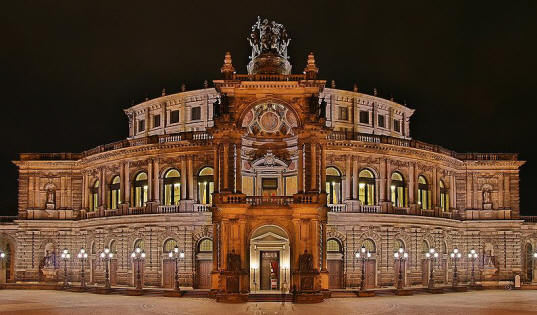
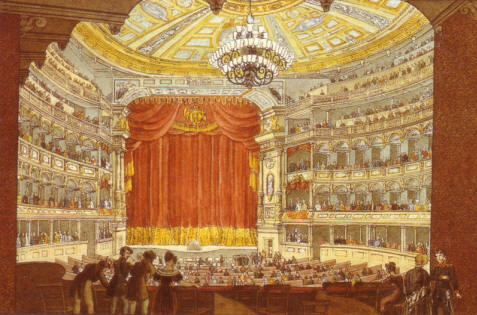
Above is the Semper Oper today
and a depiction of the stage
view in 1840. Below is the
interior today.

-
Neue Synagogue,
Hasenberg 2.
The
synagogue (left and
right) was built
in
the same place
at
which
stood
from 1840
until
the 1938 pogrom,
the
Dresden synagogue
by
Gottfried Semper
(1860, below center.)
Ground
was broken
on
November 9, 1998,
exactly 60 years
after
the destruction
of
Semper's
original
synagogue.
The
consecration
occurred on
November
9,
2001.
This New Synagogue
was
the first
synagogue
built in
East Germany.
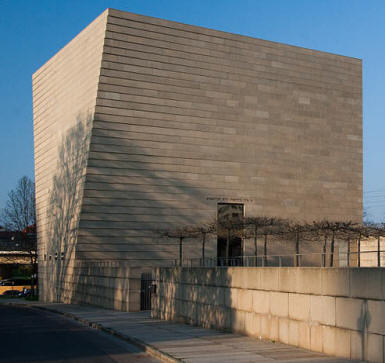
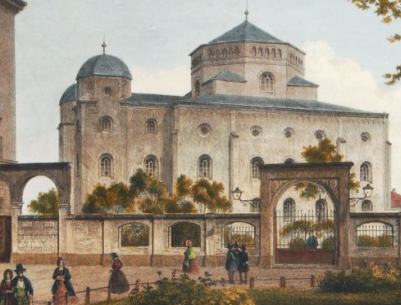
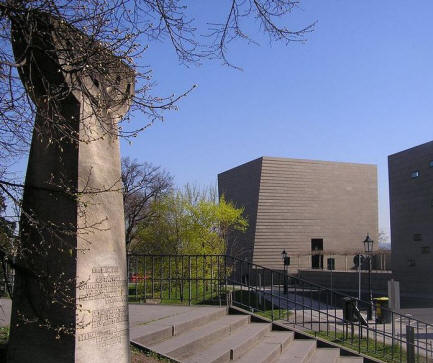
-
Elbe Valley.
The valley (red
outline on map) used to be 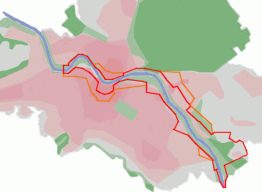 on
the
UNESCO World
Heritage List,
until the government
decided to build a
four-lane highway
Waldschlösschen
Bridge through the
heart of it. So now
it is known as "one
of only two un-UNESCO'ed
sites in the world."
still a popular tourist
attraction. on
the
UNESCO World
Heritage List,
until the government
decided to build a
four-lane highway
Waldschlösschen
Bridge through the
heart of it. So now
it is known as "one
of only two un-UNESCO'ed
sites in the world."
still a popular tourist
attraction.
-
Elbwiesen
(River Banks.)
Go to the (mostly)
green river banks,
especially in hot
summer evenings and
nights for a very
nice view of the old
parts of the city
and lots of people
playing sports and
having barbecues and
parties. There are
often big concerts
and a huge movie
screen offering
"outdoor cinema."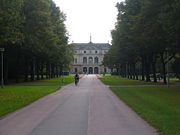
-
Kunsthofpassage.
a passage in the
middle of Neustadt
where you may find
two different
buildings, many
little stores and
some bars. A nice
complex of inner
courtyards
artistically
decorated. The
complex offers art
galleries as well as
coffee shops.
-
Fürstenzug.
(Procession of the
dukes of Saxony)
This is the largest
porcelain painting
in the world which shows
almost all Saxon
princes and kings on
their horses in
splendid parade
uniforms. It leads
to the "Stallhof" -
the last preserved
tournament place
contained in a
European castle.
(below)

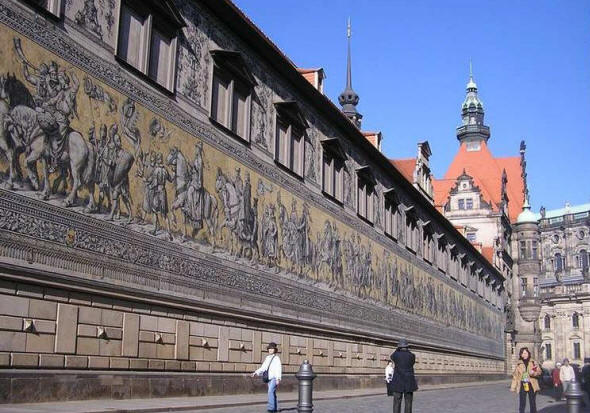
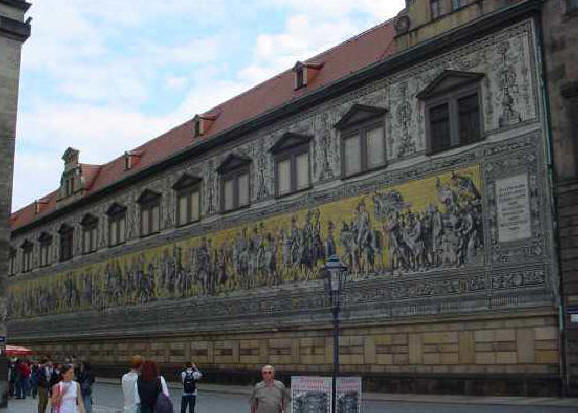
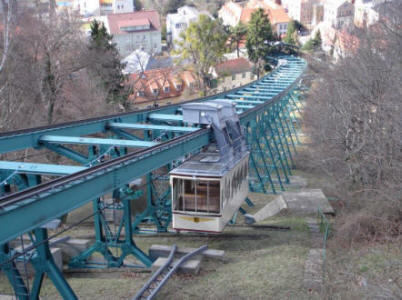
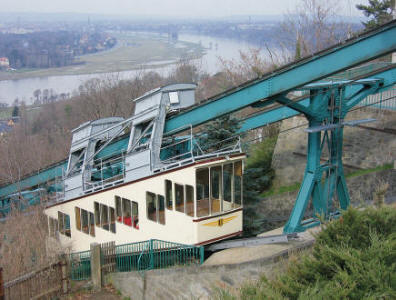
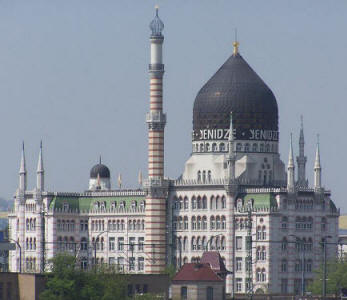
-
Yenidze
(above right) is
a former cigarette
factory which was
built between 1907-9
by the architect
Martin Hammitzsch
and is used today as
an office building.
It is notable for
its Orientalized
exterior design
which borrows design
elements from
mosques. "Yenidze"
was the name of a
tobacco company
started by Hugo
Zietz, which
imported tobacco
from Ottoman Yenidze,
Thrace (modern
Genisea, Greece.)
The "Oriental" style
of architecture
publicized the
origin of the
tobacco. It
has 600 windows of
various styles; the
dome is 66 ft (20 m)
high.
-
Gläserne Manufaktur,
Lennestrasse 1,
☎
+49-180-589-6268
(infoservice@glaesernemanufaktur.de)
Mon-fri 8AM-8PM.
The
"transparent
factory" is the site
where Volkswagen
builds its luxury
sedan Phaeton (below
left.)
English language
tour:
€5.

.jpg)
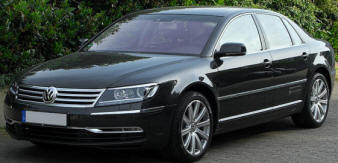 .jpg) 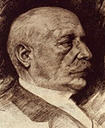
-
Pfunds Molkerei
Official Site,
Bautzner Straße 79.
A milk store which
is in the Guinness
Book as the most
beautiful milk store
in the world.
Decorated with
2,668 ft2
(248 m2) of handmade
Meissen tiles. (Mr.
Pfund, above right)
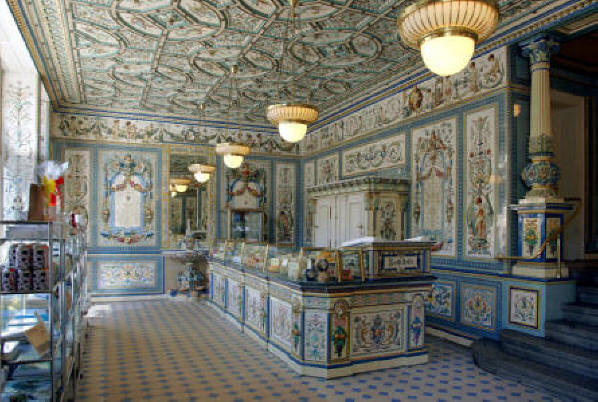
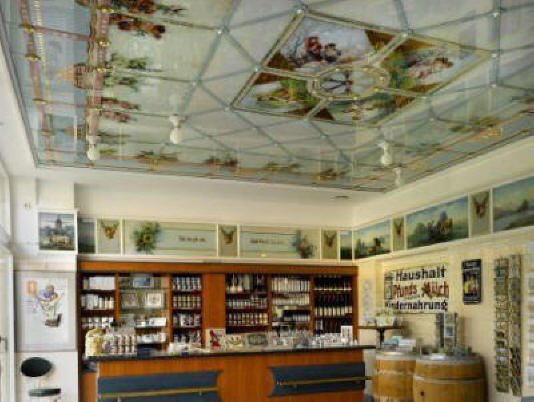
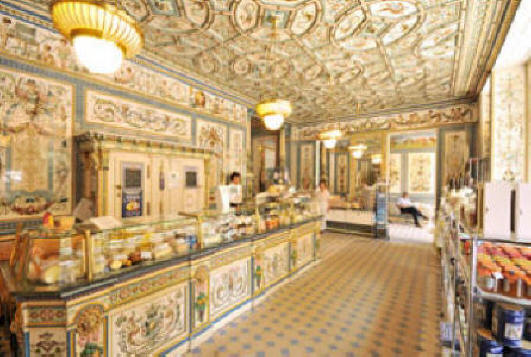

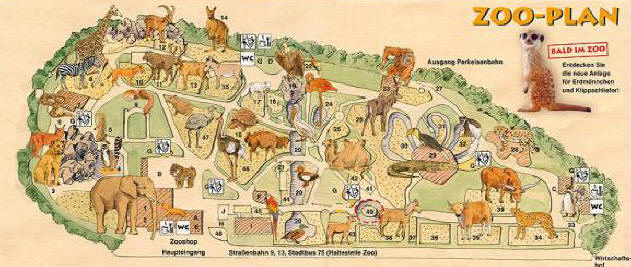
Museums
and Galleries
To see a list of all 57 Museums
located in Dresden Click
HERE.
.jpg) .jpg)

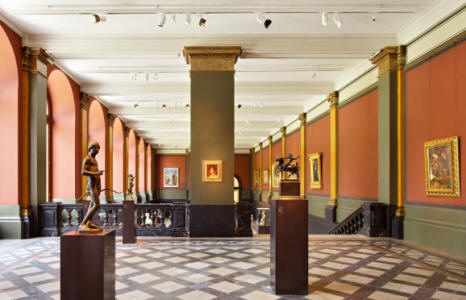
.jpg)
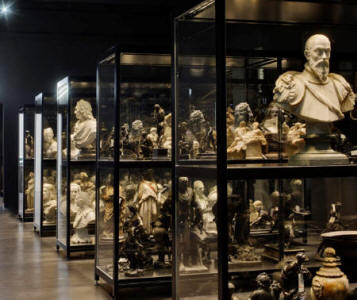
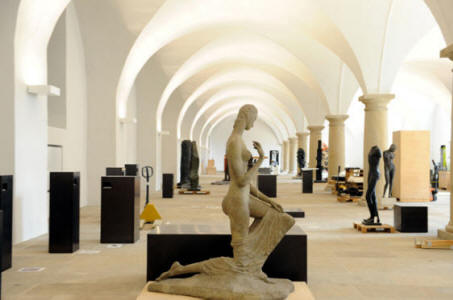
-
Japanisches Palais
(Official Site)
(on
north bank of
the Elbe between Augusbrücke and
Marienbrücke.)
The palace was
bombed out, and in
its partially
restored state holds
several small
museums, including
the museum of
natural history of
the region, the museum
of prehistory and a
display of assorted
exotic garments
(ethnological
collection.) (below)

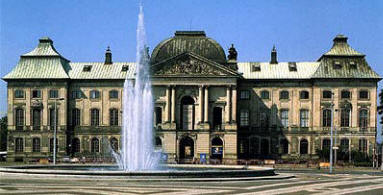

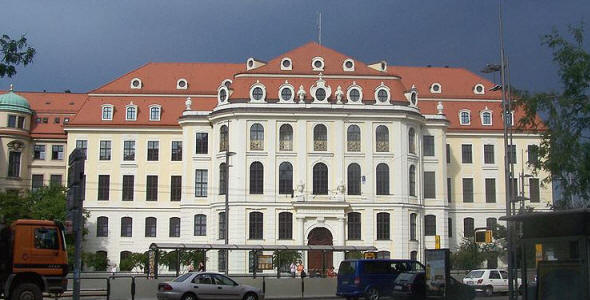
-
Kasematten
(Casement Bunker)
Brühlschen garden 4,
under
the Brühlsche
Terrasse (the
terrace at the Elbe
river.)
Apr-Oct Mon-Sun
10AM-6PM; Nov-Mar
10AM-5PM.
The remains of the
old fort gives you a
glimpse of what a
fort in a medieval
European town was
like.
Tour: €4, €2 reduced.
(below left &
center)
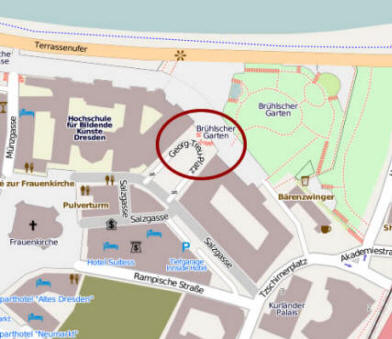 .jpg)
.png)
-
Senckenberg Museum
of Mineralogy.
Königsbrücker
Landstr. 159,
+49-351-795-841-4403.
geosciences. The
collections comprise
about 400,000
minerals, fossils,
meteorites and
stones. The
specimens in its
collections were
first mentioned in
1587 making it the
oldest geoscience
institution in the
world, (above right)
-
Erich-Kästner-Museum
Official Site.
Dedicated to Erich
Käster, the famous writer who was born
and raised in
Dresden. (below)


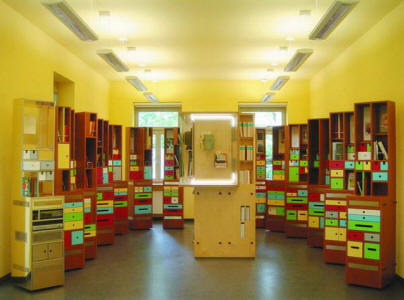
-
Military History
Museum,
(Official Site) (Tram
7-8 or bus 64 to ''Stauffenbergallee.'')
10 am - 6 pm (Mo 9
pm); Closed Wednesdays.
items and machines
of military history
of Germany and the
its
complicated
relationship with
its armed forces and
warfare.
215,278 ft2
(20,000 m2)
of indoor and
outdoor exhibition
space and 1.2
million exhibits.
adult
€5; Mondays
6 - 9 pm free.
(below)
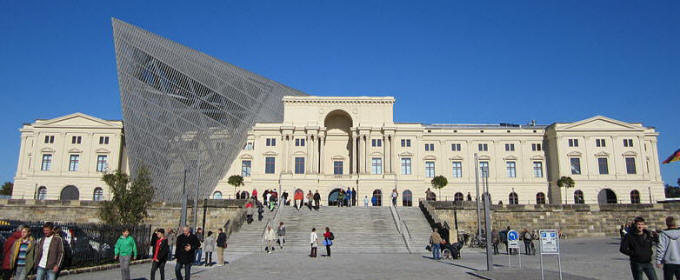
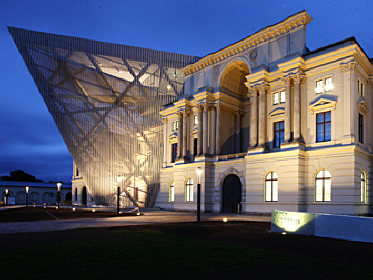
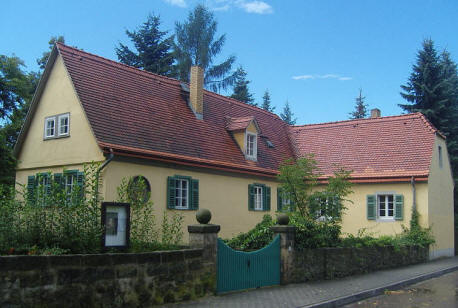
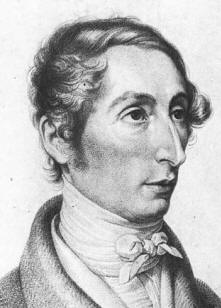
-
German Hygiene
Museum,
Lingnerplatz 1.
A comprehensive
museum dedicated to
hygiene in various
cultures. (below
left)
.jpg)
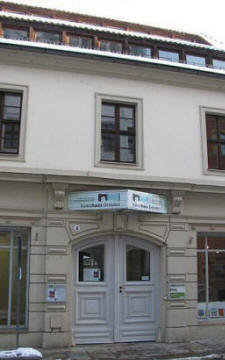
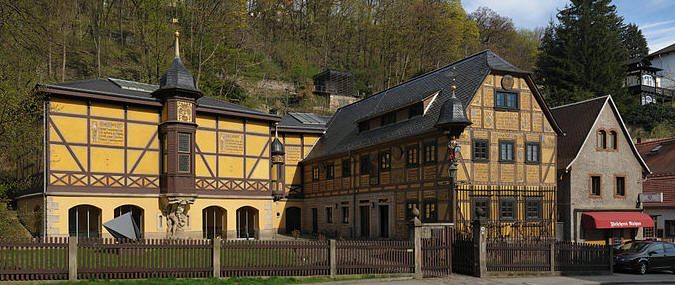
-
Kunsthof Dresden,
Görlitzer Straße 23. a farm in the Outer Neustadt in Dresden
which extends to the
Alaunstraße.
It is an assorment of public
artworks, galleries,
and shops selling
art as well as cafes
and restaurants.
To
listen to the
music of the rain (Regenwasserspiel,
below left) go
to the bottom of the
page on this link.
(below)
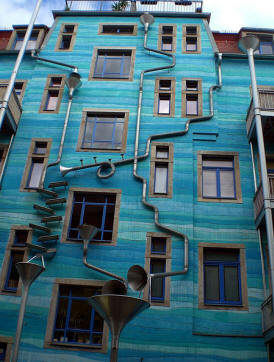
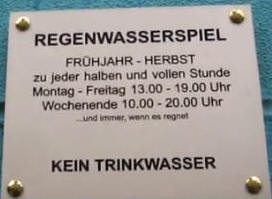
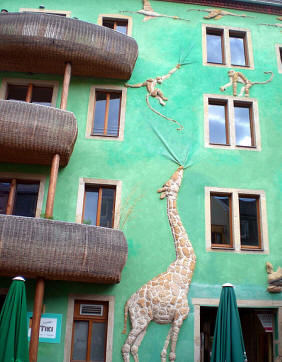
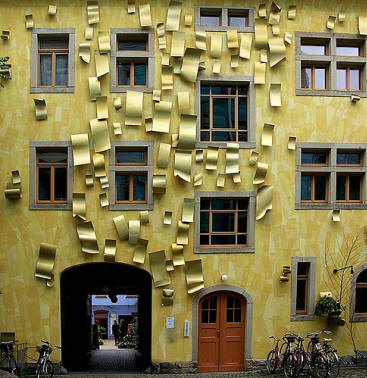
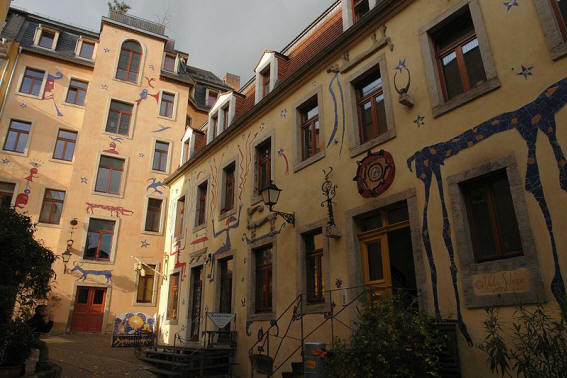
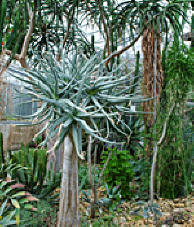
To see a list of all 57 Museums
located in Dresden Click
HERE. |
Outside
Dresden
Here are places to see only a short drive from the city.
Moritzburg Castle (Schloss
Moritzburg) is a Baroque palace
in Moritzburg, 8.1 mi (13 Km)
northwest of Dresden. The
castle has four round towers and
lies on a symmetrical manmade
island. It is named after
Duke
Moritz of Saxony, who had a
hunting lodge built there
between 1542-1546. The
surrounding woodlands and lakes
have been a favorite hunting
area of the electors and kings
of Saxony.
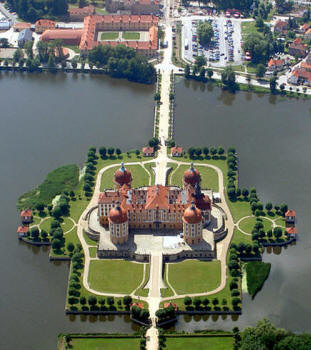
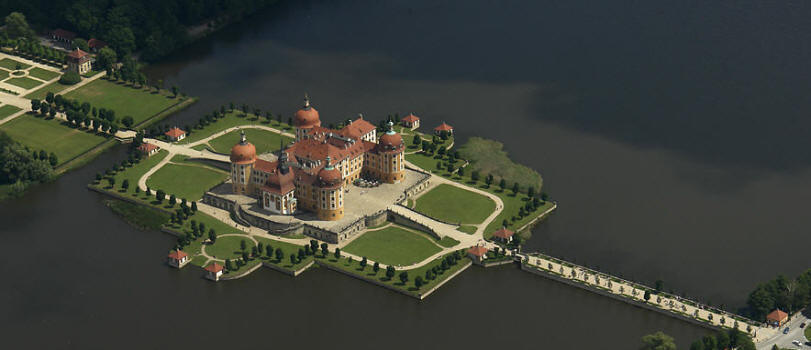
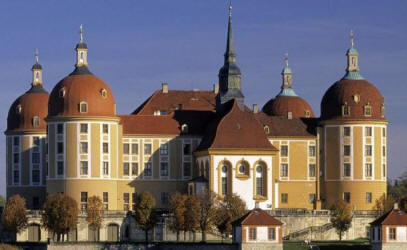
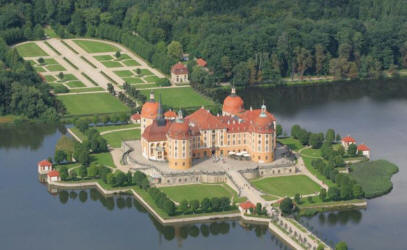
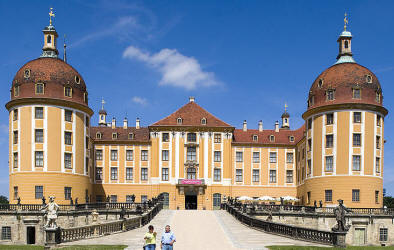
Pillnitz Castle (Schloss
Pillnitz) is a restored Baroque
castle at the eastern end of the
city of Dresden. It is
located on the bank of the Elbe
in the former village of
Pillnitz. The Castle was
the summer residence of many
electors and kings of Saxony; it
is also known for the
Declaration of Pillnitz in 1791.
The castle complex consists of
three main buildings:
-
the Riverside Palace (Wasserpalais) on the riverfront
-
the Upper Palace (Bergpalais) on the hillside, both Baroque with
Chinoiserie elements
-
the later Neoclassical New Palace (Neues Palais), which links them
together on the east side.
The buildings enclose a
Baroque garden and are
surrounded by a large public
park. Today, the castle
houses the Arts and Crafts
Museum (Kunstgewerbemuseum) of
the Dresden State Art
Collections and a Palace Museum
(Schlossmuseum).
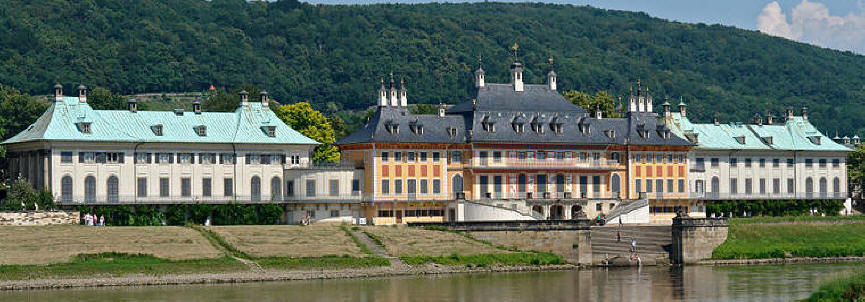
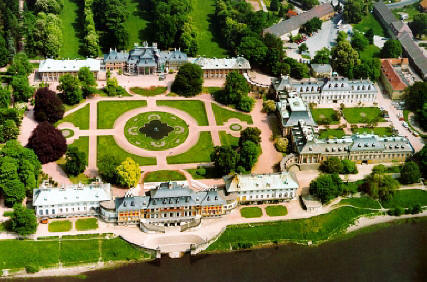
.jpg)
Basteibrücke Below are stock photos of the mountainous areas just
south of the city and the famous Basteibrücke (Bastei Bridge.) We missed
all three but they are all big tourist attractions and worth seeing.
%20(2).jpg)
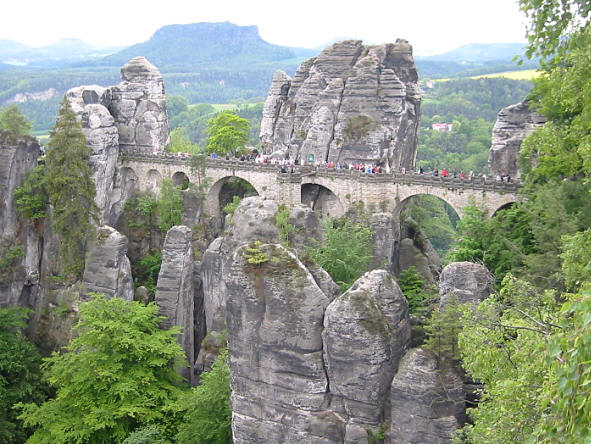
Below is an aerial view of a bend in the Elbe River from the rocks above.
.jpg)
I woke up at 6:15 and then again at 9:30 and
then got up; put my running gear and
rain gear on for church and by 10:15 I was running to central Dresden in the
pouring rain
to find the main Catholic Hofkirche. I took these photos after Mass when the sun came out.
.JPG)
.JPG)
It's really quite a beautiful structure right next to the river. It was
built from 1738 to 1751 by order of King
Frederick Augustus II, after the Protestant city of Dresden built the
Frauenkirche (Church of Our Lady) between 1726 and 1743. The King
decided that a Catholic church was needed in order to counterbalance the
Protestant Frauenkirche. He hired Italian architect
Gaetano Chiaveri to build it and he brought all his workers from Italy.
The King (August the Strong) had converted to Catholicism in order to also
become King of Poland. Building this in this ardently Protestant city
required compromises even for a king. The church bells never rang until
Napoleon captured Saxony in 1806. The aisles were made large for
processions because they were not
allowed to have them in the streets. Below is what it looked like in 1840.
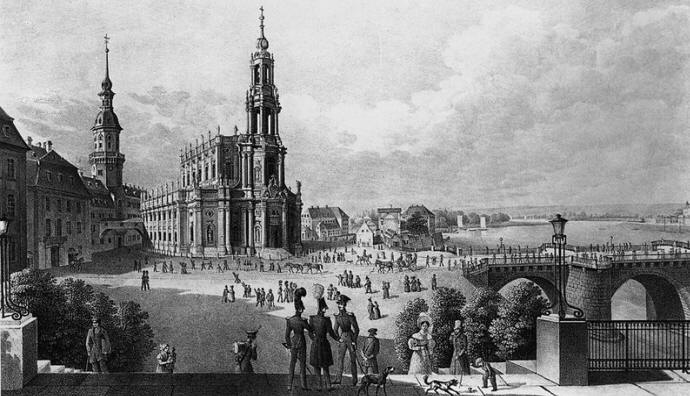
The bell tower is 272 ft (83 m) high. Along the
exterior sides there are 78 statues
10 ft (3 m) tall. When Augustus died, he was buried in Krakow
as King of Poland (below left,) but asked that his
heart be placed in a plain copper vessel (below center) in the crypt below the Cathedral
here, next to
the coffins of the Wettin princes (below right.)
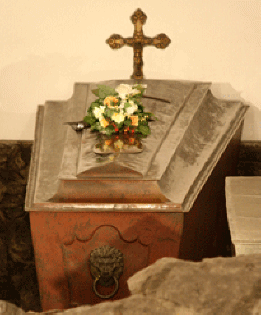
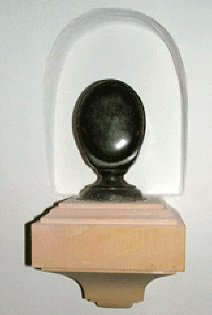
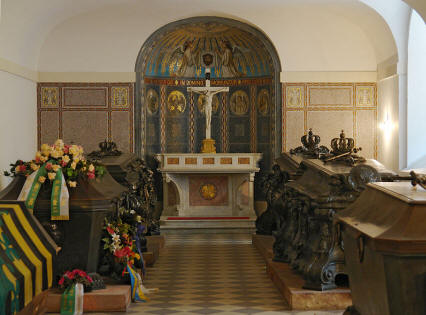
I
was glad to get inside the massive cathedral (out of the rain) and because of the rain, I
had to finish my fast walking in circles in
one of the chapels in the back of the church (below.) I was lucky it was
empty.
.JPG)
When I was done, I attended the 10:30 Mass at the
Hofkirche which is called the Kathedral Sanctissimae Trinitatis
(Holy Trinity Cathedral.) Inside they had a map of all the Catholic
churches in Dresden.
.JPG)
They also had this procession ceremony with flags
(below left) inide. The side altars and
statuary were very nice and seemed to be kept up and very pristine.
.JPG)
.JPG)
.JPG)
The interior was quite dramatic in this Romanesque-Gothic structure. It is
hard to believe that it was completely destroyed in the bombings during WWII and
restored afterwards. Below is the view to the rear of the
church with the historic organ.
.JPG)
.JPG)
Below is a stock photo of the massive ceiling. On the right is the view toward
the altar. It is much prettier inside than outside.
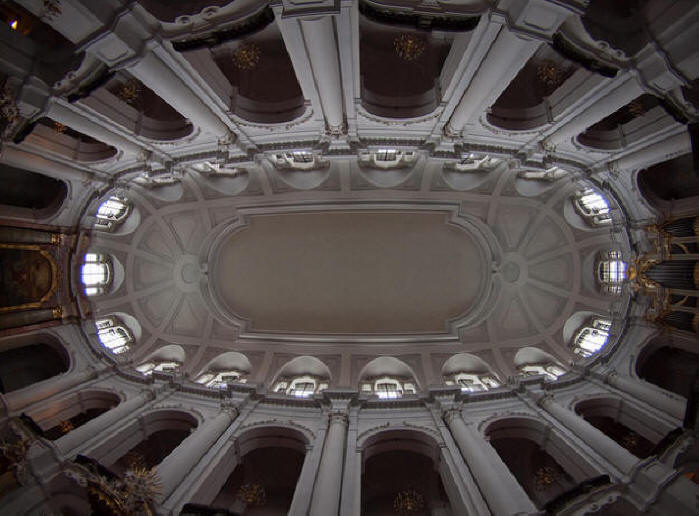
.JPG)
These are closer shots of the marble-laid altar with
its silver
candelabras.
.JPG)
.JPG)
Here is one of the side altars (left) and their elaborate pulpit and stairway to
it.
%20(2).JPG)
.JPG)
.JPG)
.JPG)
After photographing the beautiful interior
and the exterior in the sunshine (above,) at 11:45 AM, I started wandering
around and taking photos of the architecture.
.JPG)
.JPG)
.JPG)
I decided to head for the large bridge that was depicted in many of the
paintings shown above. It is called the Augustusbrücke or Augustus Bridge.
On the bridge is this large stone carving of slaying a lion.
.JPG)
.JPG)
The brdige is very solid. On the right is the view looking back toward the
city.
.JPG)
.JPG)
Here is the view I got looking down the River Elbe.
.JPG)
And here is the view looking up the river. You can see they have docking
for river cruise ships.
%20(2).JPG)
I
got off the bridge and headed over to take
pictures of the SemperOper (Semper Opera House.)
This large plaza is called Theaterplatz and it is a very impressive and a beautiful central area surrounded by all these
buildings. The Zwinger Palace is in the center and the SemperOper is
outside this panorama (below.)
.jpg)
Below are my shots of the SemperOper and its central entrance area.
.JPG)
.JPG)
.JPG)
Above is a closer look at the dome above the entrance. Below is the
statue of King Johann
(1801-1873) (below) which sits out front of the Opera House.
.JPG)
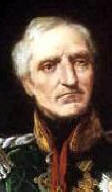
.JPG)
.JPG)
Below left is the Zwinger Palace Salon of Mathematics and Physics which houses a
collection of scientific instruments and a collection of porcelain.
.JPG)
.JPG)
Below is a shot of the Zwinger Palace.
.JPG)
.JPG)
The Zwinger was built in Rococo
style and designed by court architect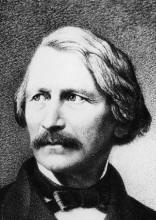 Matthäus Daniel Pöppelmann (right.)
Matthäus Daniel Pöppelmann (right.)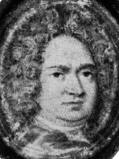 It served as
the orangery, an exhibition gallery and
festival arena of the Dresden Court.
The location was formerly part of the
Dresden fortress of which the outer wall is
preserved. The name derives from the German
word Zwinger (outer ward of a
concentric castle;) it was for the
cannons that were placed between the outer
wall and the major wall. The Zwinger was not
enclosed until the Neoclassical building by
Gottfried Semper (1803-1879) (left) called the
Semper Gallery was built on its northern
side. Semper also did the original Synogogue and the Opera House. Today, the Zwinger is a museum
complex that contains the
Gemäldegalerie Alte Meister (Old Masters
Picture Gallery,)
the
Armory (Rüstkammer,) both of which I
plan to visit today, as well as the
Dresden Porcelain Collection (Porzellansammlung,) and the
Mathematisch-Physikalischer Salon
(Royal Cabinet of Mathematical and Physical
Instruments.)
It served as
the orangery, an exhibition gallery and
festival arena of the Dresden Court.
The location was formerly part of the
Dresden fortress of which the outer wall is
preserved. The name derives from the German
word Zwinger (outer ward of a
concentric castle;) it was for the
cannons that were placed between the outer
wall and the major wall. The Zwinger was not
enclosed until the Neoclassical building by
Gottfried Semper (1803-1879) (left) called the
Semper Gallery was built on its northern
side. Semper also did the original Synogogue and the Opera House. Today, the Zwinger is a museum
complex that contains the
Gemäldegalerie Alte Meister (Old Masters
Picture Gallery,)
the
Armory (Rüstkammer,) both of which I
plan to visit today, as well as the
Dresden Porcelain Collection (Porzellansammlung,) and the
Mathematisch-Physikalischer Salon
(Royal Cabinet of Mathematical and Physical
Instruments.)
It was now time for me to start touring a little by seeing some galleries.
I started my visit in the Rüstkammer in the area with the guns and armor.
There was this beautifully elaborate backgammon game (below left) and then all
the ancient hand guns.
%20e.jpg)
.JPG)
.JPG)
.JPG)
The 16th Century armor on the soldiers and horses were quite spectacular in all their
gleaming etched metal.
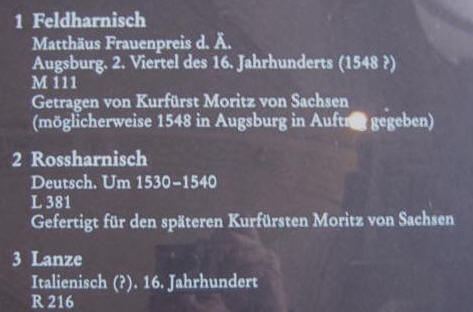
.JPG)
.JPG)
.JPG)
.JPG)
.JPG)
.JPG)
%20(2).jpg)
I eventually wandered into the art museum part (Gemäldegalerie Alte Meister) and
came across the beautiful landscapes by Canaletto (Bernardo Bellotto) who had
moved here to Dresden from Venice and lived here a long time. On the left
is the stock photo I found of it (in black borders) and on the right
are the photographs I took of the art piece. Remember, if you have no interest in art,
just scroll quickly past it all.
An Aside
There are two so-called "Canalettos."
The first is the uncle, the original, whose name was
Giovanni Antonio
Canal (below center) (1697-1768.) To differentiate him
from his father, he was called "little Canal" or in Italian
"Canaletto." He became famous for his landscape paintings such
as those below of Venice. He spent time in London but returned
to Venice where he died. The other is his nephew,
Bernardo
Bellotto (1721-1780) who was trained by his uncle and also did
landscapes of Venice but later moved to Dresden at the invitation of
the King and later to Russia and Poland where he died in Warsaw.
He signed his paintings as "Canaletto."
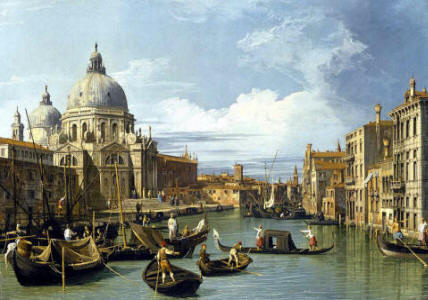
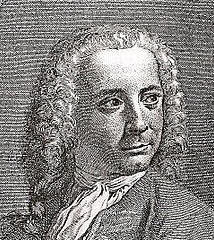
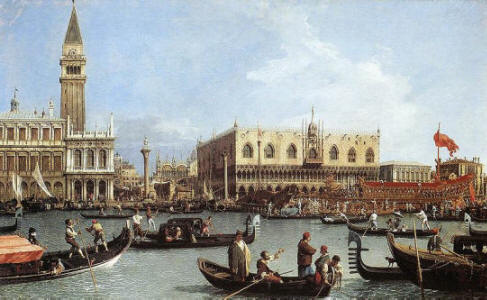
To see all the artists in this museum, click
here.
The first art I came upon were the great landscapes of Dresden by Bellotto as
"Canaletto." Remember on the left is the stock photo and on the right are
the photos I took.
Canaletto (Bernardo Bellotto) "Dresden
from the right bank of the Elbe above
the Augustus Bridge") 1747
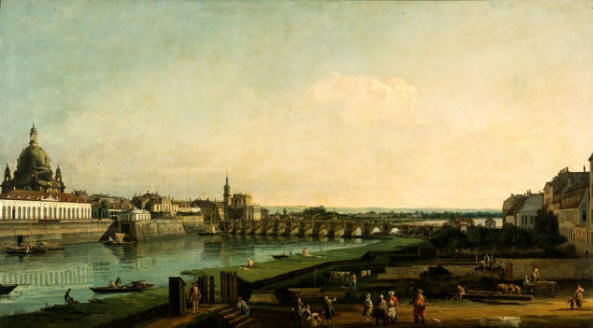
%20(2).jpg)
Canaletto "Dresden seen
from the left bank of the Elbe
fortifications"1748
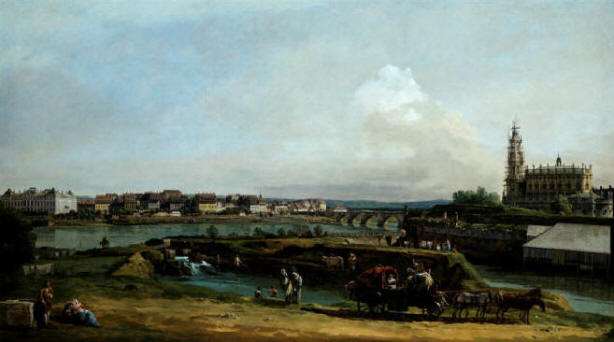
.jpg)
Canaletto "The ruins
of the former Church of the Cross
in Dresden" 1765
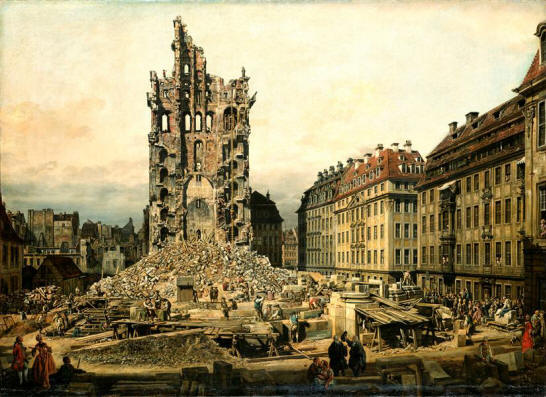
%20(2).jpg)
Canaletto "View of Marketplace in City of Pirna"
.jpg)
.jpg)
Here are a few I never found the name of the work or the artist.
%20(2).jpg)
.jpg)
%20(2).jpg)
I went through many more than I have photos of here and I was getting a little
tired, so at noon, I stepped
outside the museum to their Alte Meister Café for a cappuccino which cost a
whopping €6 and I
also bought a book on Dresden for
€8.50.
.JPG)
.JPG)
I nice gentleman asked if I wanted my picture taken. Of course I'm still
in my running outfit which by now has dried out. After reading and
relaxing, at 12:50, I walked over to the Zwinger Café and had another cappuccino for €5.
Well rested, at 1:40, I reentered the gallery and got back to where I left off,
in the Canaletto section.
Canaletto "Dresden
from the right bank of the Elbe below
the Augustus Bridge"
1748
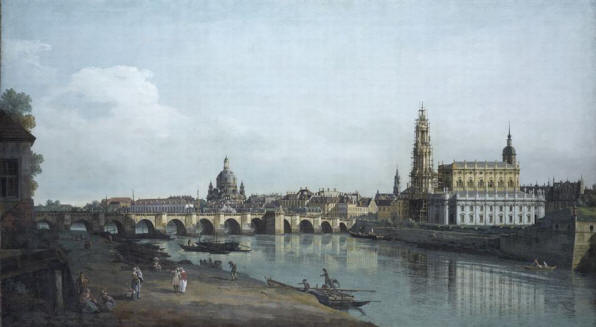
%20(2).jpg)
Canaletto "The
Neumarkt in Dresden
from from Moritz
Strasse (Neumarkt Hauptwache)"1750
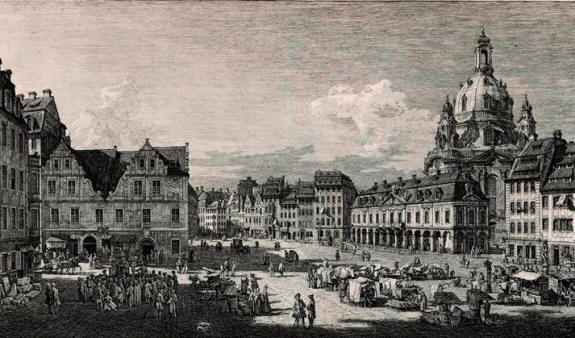
%20(2).jpg)
Canaletto "Der Zwingerhof in Dresden" 1752
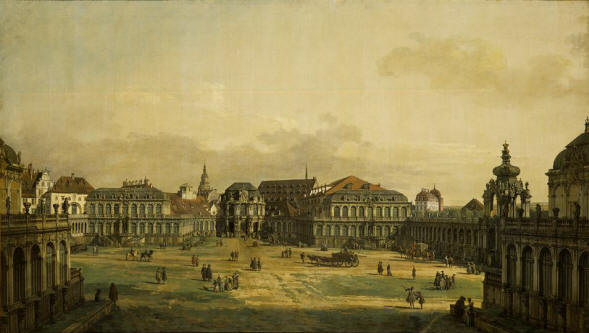
%20(2).jpg)
Canaletto "Neumarkt in Dresden from Jüdenhofe" 1749
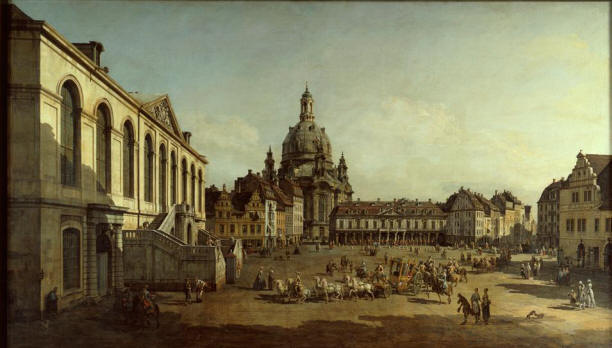
%20(2).jpg)
Canaletto "Der Neustädter Market in Dresden" 1750
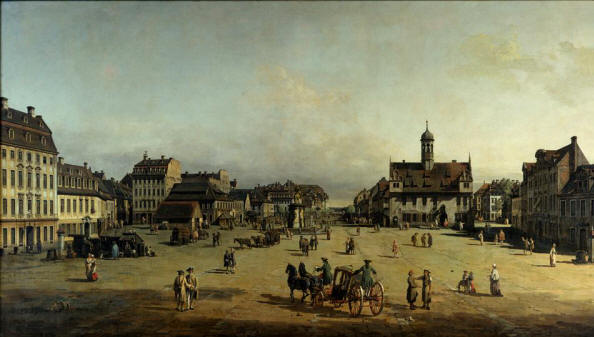
%20(2).jpg)

As you can see, these landscape
paintings by Canaletto and other painters were very useful in helping restore the city
after its WWII destruction. After Canaletto, I came across the famous
painting by Raphael called the "Sistine Madonna." Note the little angels (or putti
in Italian) at the bottom of the painting (right) which
have been used in many things and in many places.
Raphael (1483-1520) "Sistine Madonna"
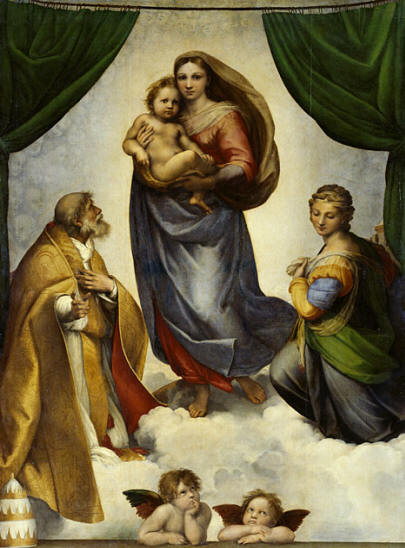
%20(2).jpg)
Then there was a plethora of so many beautiful pieces of art by the most famous
and well-regarded artists in history.
Garofalo "Triumph of Bacchus" 1540
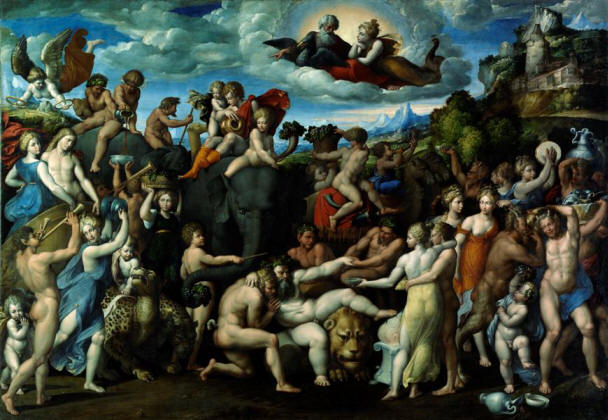
%20(2).jpg)
Botticelli "Life of St Zenobius" 1500
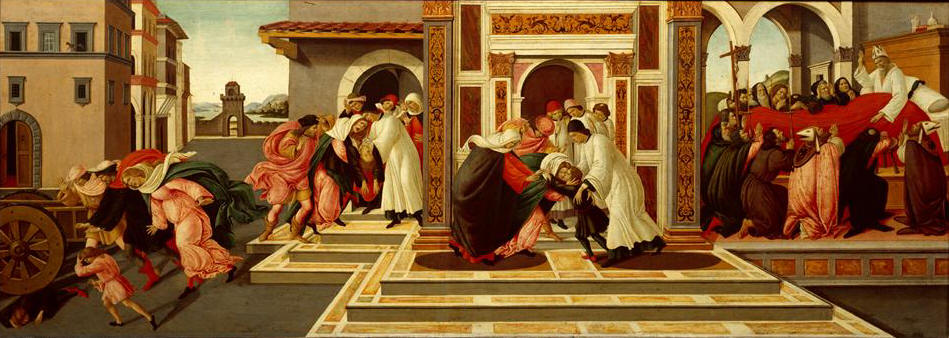
My photo of the above and Botticelli's "Madonna and Child and St. John" 1500
%20(2).jpg)

Antonello da Messina "St Sebastien" 1478; another St. Sebastian (unknown
artist.)
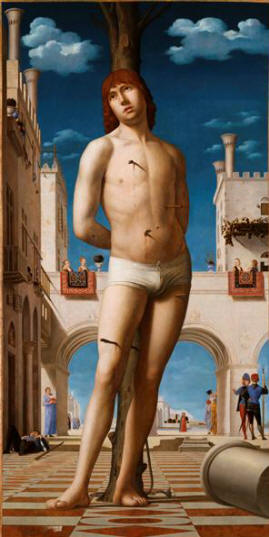
%20(2).jpg)
%20(2).jpg)
Annibale Carracci (1560-1609) "St. Sebastian" 1583
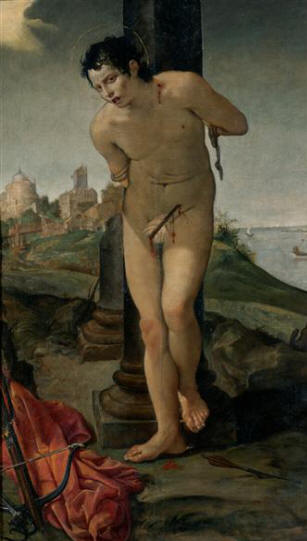
%20(2).jpg)
Nicolas Regnier (1590-1667) "St. Sebastian" 1625
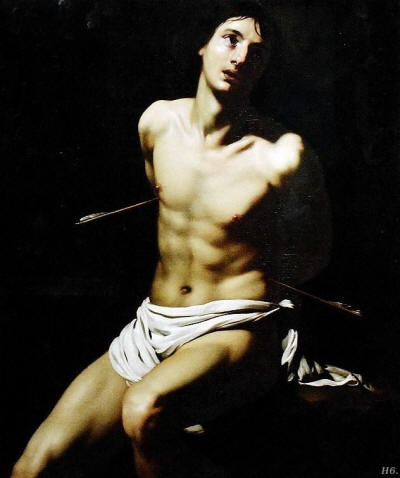
%20(2).jpg)
Nicolas Poussin (1594-1645) "Reclining
Venus and Amor" 1624
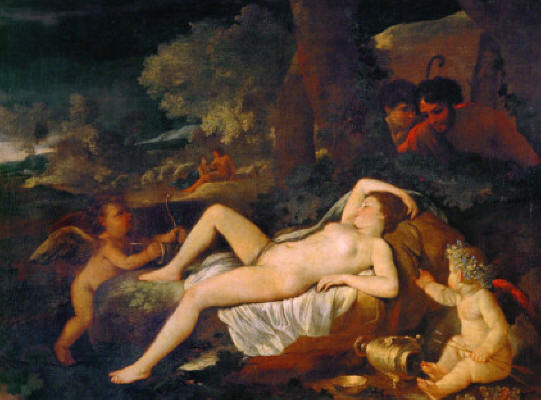
%20(2).jpg)
El Greco "Christ Healing the Blind Man" 1560
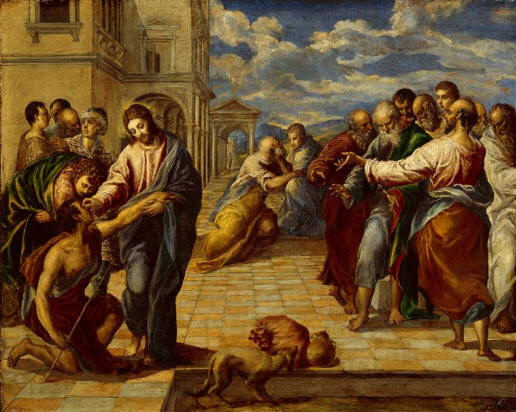
%20(2).jpg)
Adriaen van de Velde (Dutch 1636-1672) "Amusement on the Ice on the Moat" 1669
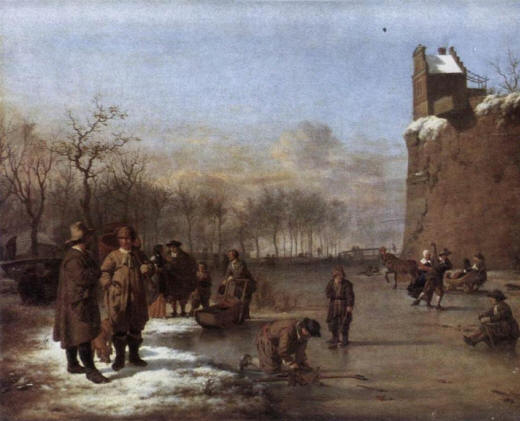
%20(2).jpg)
Saloman de Bray (1597-1664) "Garlanded Young Man" 1635.
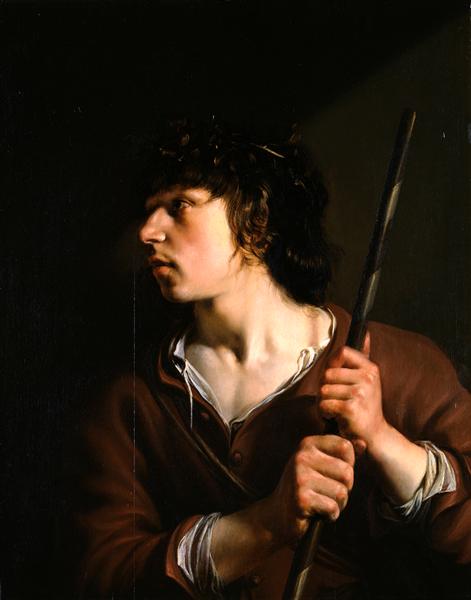
.jpg)
Gerard van Homhorst (1590-1656) "Der Zahnarzt" (The Dentist) 1622
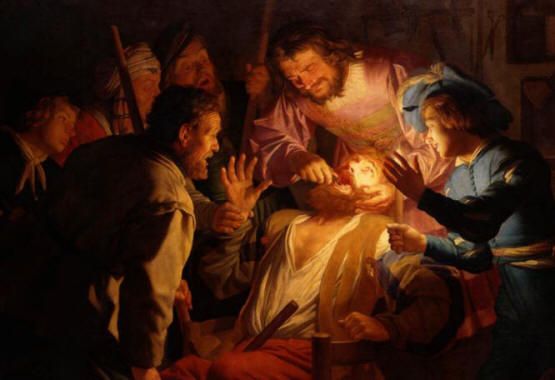
%20(2).jpg)
Rembrandt van Rijn (1606-1669) "Ganymede
in the clutches
of the Eagle"
1635

%20(2).jpg)
Rembrandt van Rijn "Portrait of the Young Saskia van Uylenburgh of Munchen" 1633.
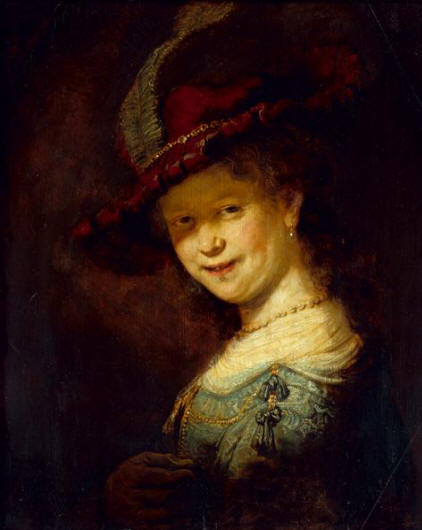
.jpg)
%20(2).jpg)
.JPG)

Raphael (above right) (1483-1520)
"The Miraculous Draught of Fishes" 1623; "Commanding
St. Peter" 1624.
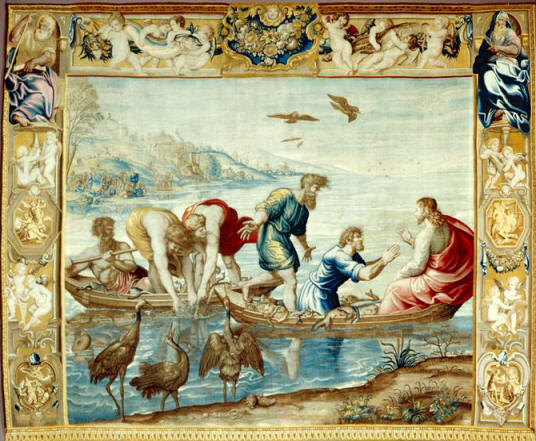
%20(2).jpg)
Otto Dix (1891-) "Der Krieg" 1932
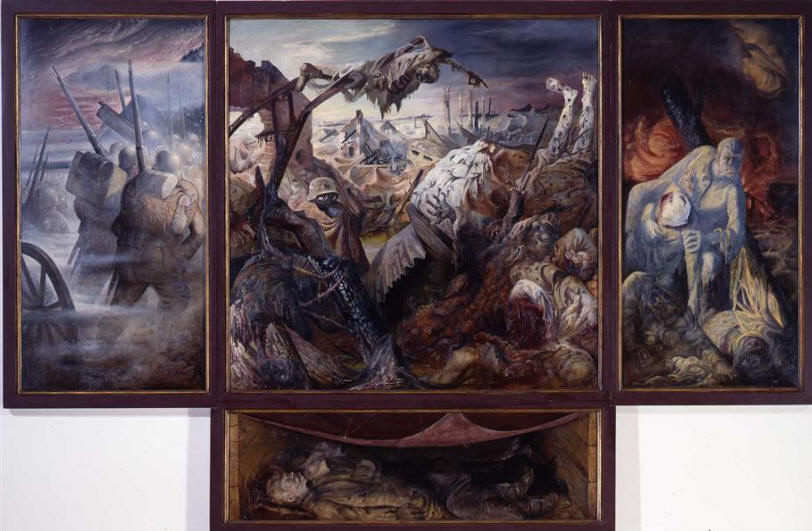
Life of Otto Dix and my shot of "Der Krieg"
%20(2).jpg)
.JPG)
Lucas
Cranach the Elder "Adam," and "Eve" 1531;
"Two dead Waxwings" 1530
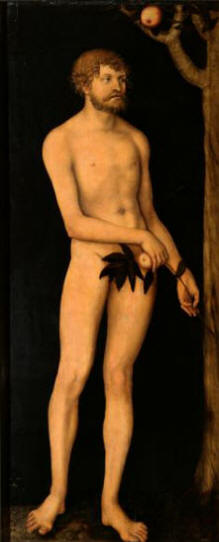
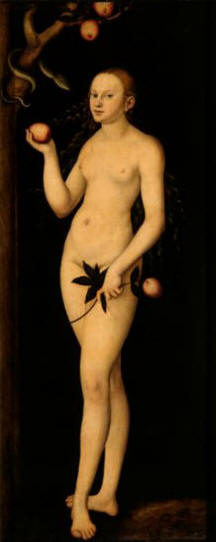
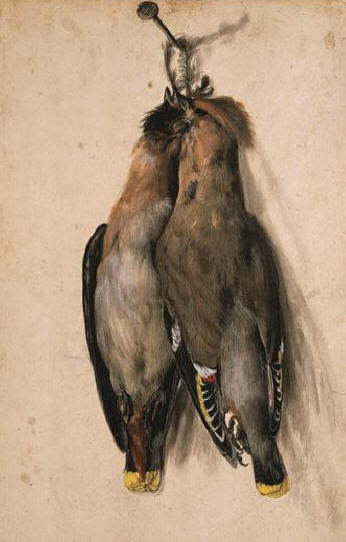
Cranach "Martin Luther" 1532; Bartolomeo "Salome with Head of John the
Baptist;" Gaugin "Parau Api Gibts was Neues" 1892
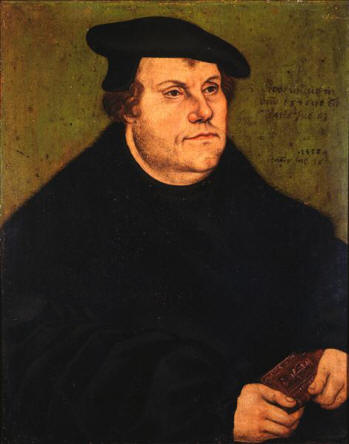

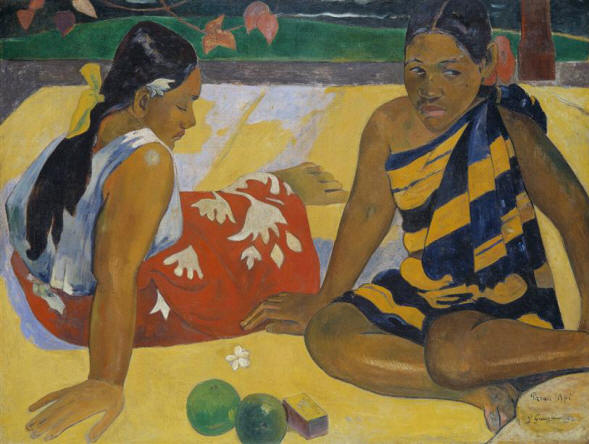
Fra Angelico "The Visitation"; Albrecht Dürer
"Berhard von Reesen" 1521
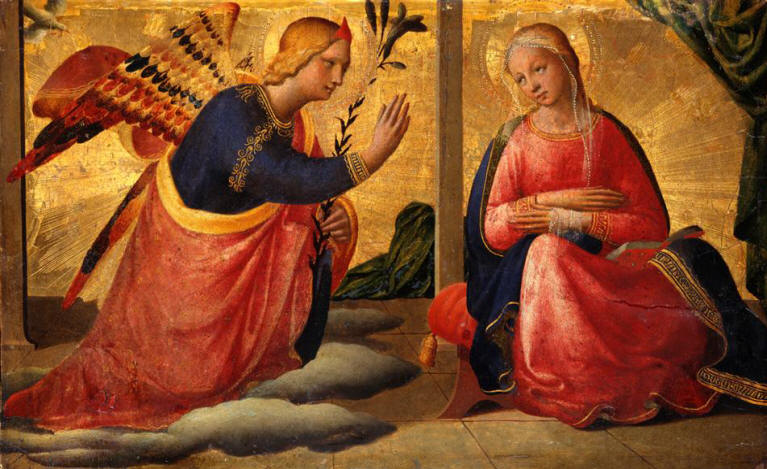
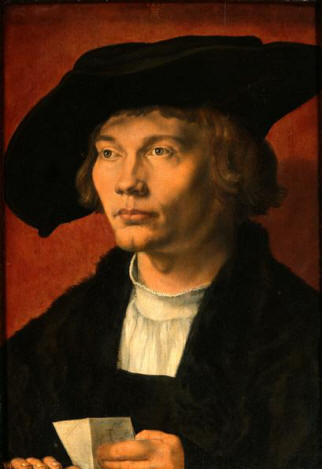
Albrecht Dürer "The Crucifixion" 1496; Hans
Holbein "The Madonna", Holbein the Younger "Charles Solier" 1535
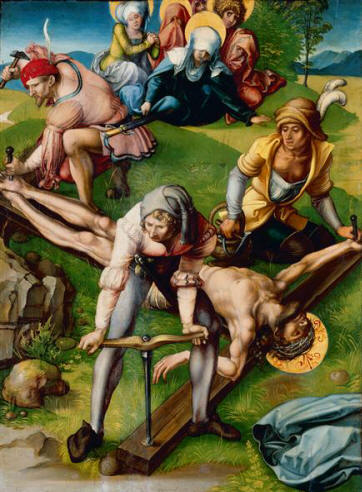
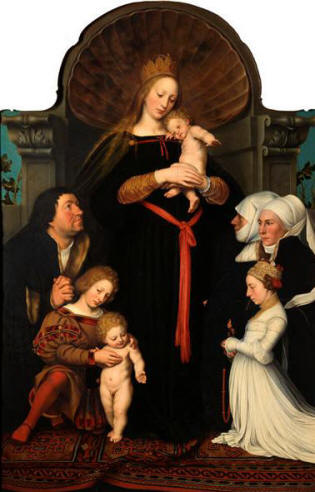
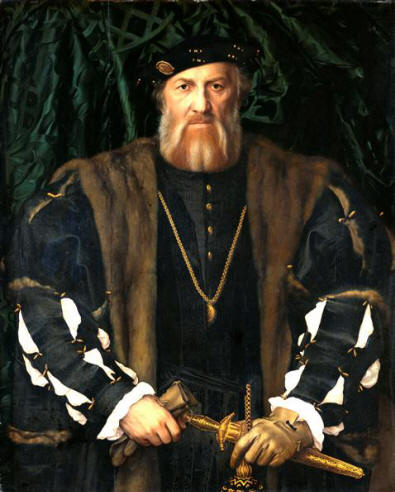
Veronese "Capernum" 1582; Velazquez 1635
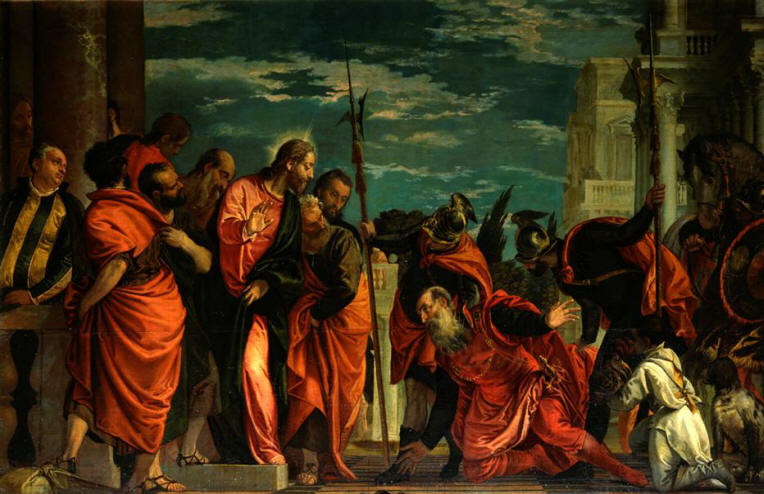

Tizian "Alvise dalla Scala" 1562; Tintoretto
"Musical Women" 1566

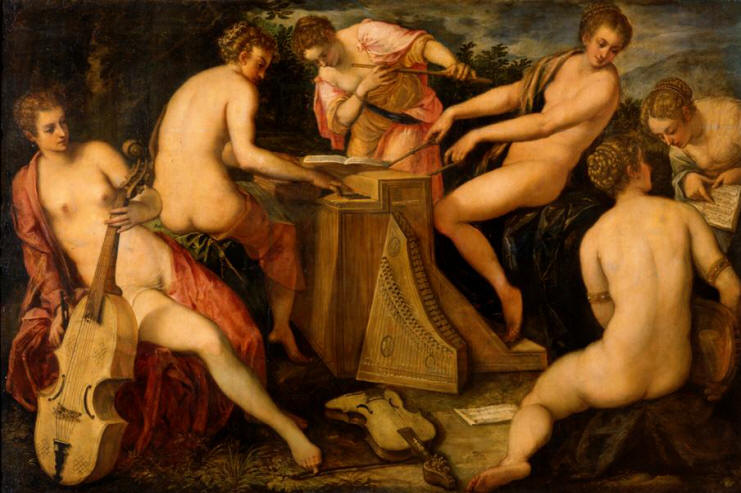
Rubens "The crowning of Tugenheld by the Goddess" 1616;
Rubens "Drunken Hercules with nymph and satyr" 1616

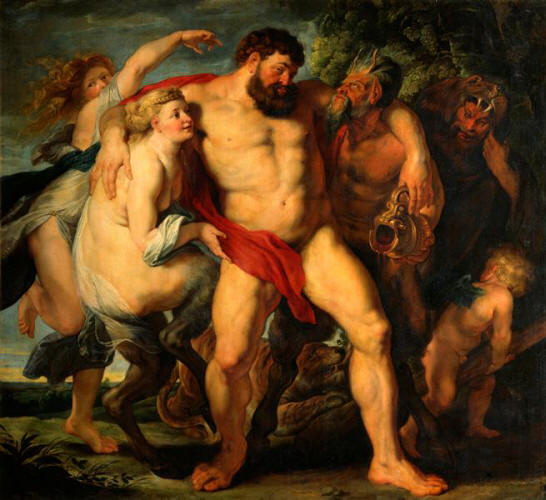
Jusepe Ribera "St Andrea"; Zubaran "St
Bonaventure" 1629

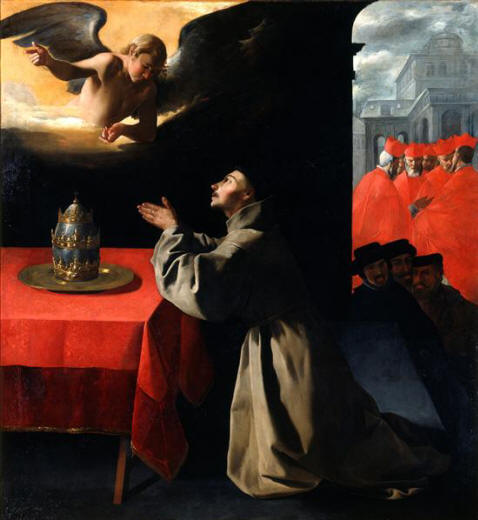
By 3:40 I had finished all three floors of the gallery and was
really ready to relax. I was worn out. As you can see, some of the great art of the world
is held here in Dresden. I headed out into the Theaterplatz and found this
building called the
Italienisches Dörfchen
(Italian Village) right along the Elbe River (below.) Below is the front
of the building which holds an office of a winery called
Jakob Gerhardt Weingut (Oberdorfstraße
27, Nierstein (map, western Germany,
 +49-6-133-5070.)
+49-6-133-5070.)
.jpg)
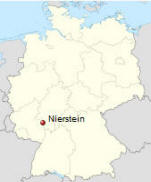
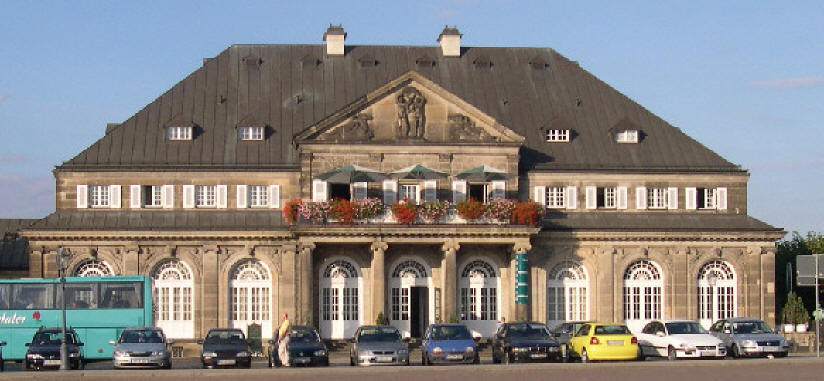
Below you can see the full extent of the building and that it is right on the
river's edge.
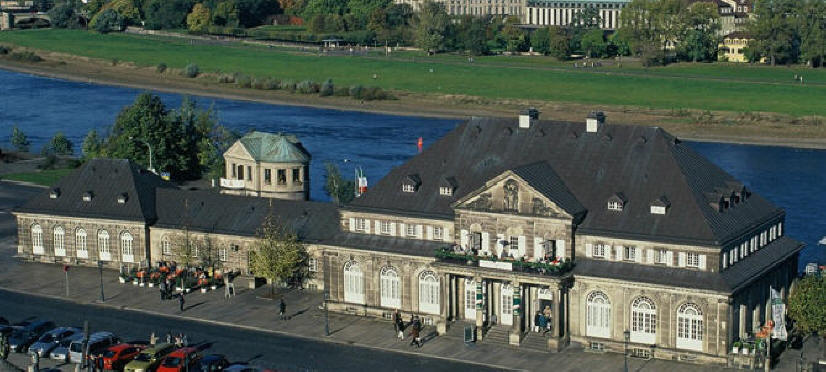
This is where the Italian workers lived when they were working on all the
construction in the city such as the Hofkirche. Below is some of their
stonework on the building. I discovered they had a restaurant in the
building called "Bellotto" and at 3:50 I made a reservation for dinner there since
it looked like ideal spot.
.jpg)
.jpg)
As part of the complex, I found this little bar called Piccolo [ +49-35-498-1628] so at 4 PM I sat down and had a cappuccino and a small bottle
of Pellegrino on their scenic terrace overlooking the Elbe. Below, I could
look down upon their biergarten.
+49-35-498-1628] so at 4 PM I sat down and had a cappuccino and a small bottle
of Pellegrino on their scenic terrace overlooking the Elbe. Below, I could
look down upon their biergarten.
.jpg)
.jpg)
I got some photos of the tower on the Semper Opera House and the statues that
adorn it.
.JPG)
.JPG)
At 5:20 I walked back to our hotel to get changed and go to dinner.
Over the past 40 years Marcia has tried to ignore the electronic revolution that
has swirled around her, but she has gotten very good with the cell phone and
texting and finally agreed to do email. For some reason today she really
wanted to check her email which is rare when we are traveling. I got her
on the hotel computer and she got it done.
.jpg)
Then the two of us took a lovely walk back to the same area I was in and at 8 PM we
went for dinner at Bellotto at the Italienisches Dörfchen [Theaterplatz
3,
 +49-35-149-8160.] It is named after the famous artist Bernardo Belloti who
was called Canaletto (see above.) They have an outside patio deck looking
over the river (below right.)
+49-35-149-8160.] It is named after the famous artist Bernardo Belloti who
was called Canaletto (see above.) They have an outside patio deck looking
over the river (below right.)

To see 360 views of the beautiful entrance and the different restaurants and
bars click
here. This is really quite a place. Here is the ornate entrance
area.
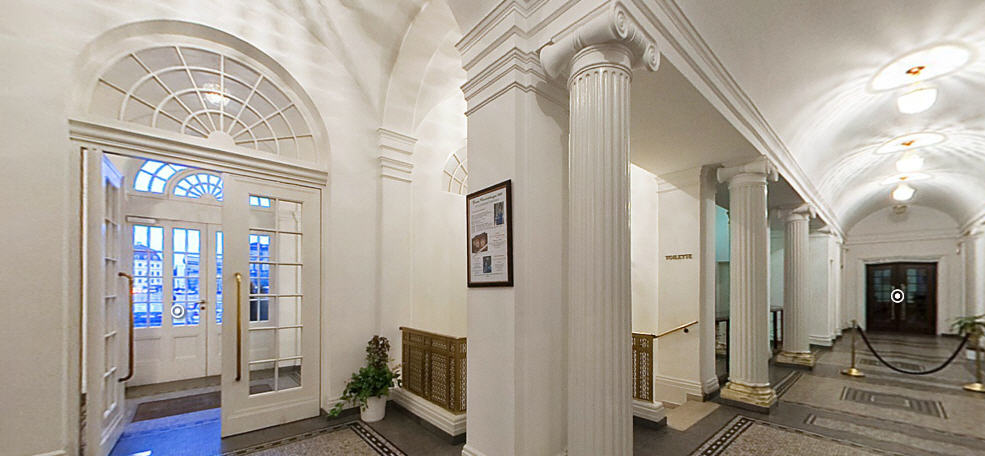
We decided to first have a beer and wine in the Belloti Bar on the first floor.
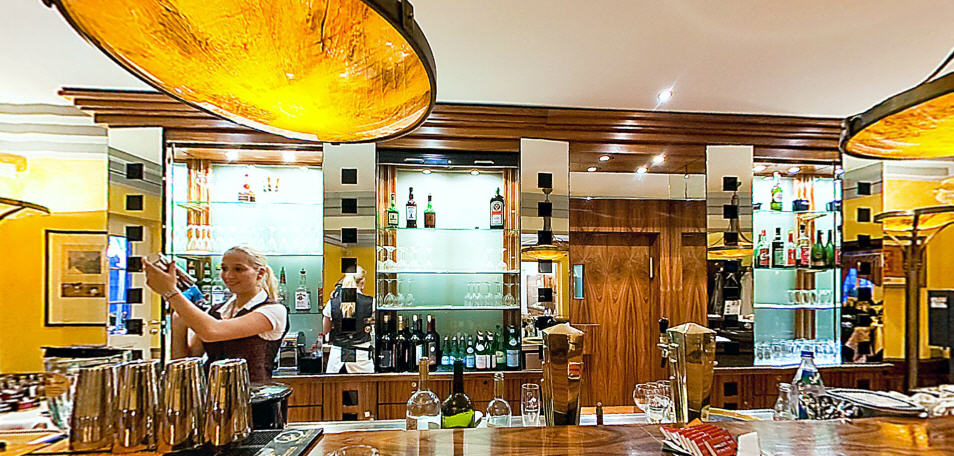
Their bar was very modern and fancy. I had a Freiberger pils and Marcia a
glass of chardonnay.
.jpg)
.jpg)
We
chose to be seated at a lovely table outside (like everyone else) on their other
veranda overlooking the huge Theaterplatz and we decided to relax for a while and enjoy the
beautiful view while sharing bottles of Pellegrino water and a 2005 Italian Villa Antinori Toscana vino bianco.
.JPG)
%20(2).JPG)
%20(2).JPG)
What a beautiful setting with the Semper Opera House right in front of us.
%20(2).JPG)
%20(2).JPG)
We looked over their menu and since it was in Italian, it was easier for us then
if it was in German,
.jpg)
.jpg)
.jpg)
As an appetizer, Marcia had an insalata sedane e nocci con avocado
(celery and walnut salad with avocado (which was unripe)) (below left) and I had a very tasty vitello
tonnato (cold sliced
veal covered with a tuna sauce) (below right.) It doesn't usually come with all that
stuff on top which I would have preferred not to have.
.JPG)
.JPG)
It was very good anyway; really Italian. During dinner, Marcia had a German chardonnay and I had two Freiberger pils
beers.
For an entree, she had pesce spada (swordfish) with a ragu (below left) and I had paparadella in
a duck stew (below right.) Both were really excellent.
.JPG)
.JPG)
Here is a view of the plaza we had during our dinner. It was beautiful
watching the sunset.
.jpg)
I took this shot of the Opera House with the flash on (left) and without it
(right.)
.JPG)
.JPG)
As I wandered around the restaurant, I came across this painting of a girl named
Chrisane Beulmann and this locked cabinet displaying all kinds of pasta.
.jpg)
.jpg)
During dinner, we met a very nice couple from Augsburg (in Bavaria.) Their
names are Raouf Kneuse and Dagmar Fuß. We had a very good time chatting
with them.
.JPG)
.jpg)
%20(2).JPG)
.jpg)
At 11:45, we left
the restaurant and took a taxi back to the hotel. It cost €6.80 but our
cab driver was an Iraqi from the city of Basra and he refused to take any tip from
us in
appreciation of what America has done for his country. I was very touched.
What a very busy and full day this was.
KJH
Go
To -> NEXT DIARIO #12
Kenneth J. Hoffer, MD
KHofferMD@AOL.com

Dresden, Germany
Sent 1-17-2013
Return to
Top of Page
If you enjoyed these travels or wish to add comments on the places we visited
Please Leave Me a Message by clicking the spinning @ sign.
Click Here To: 



We Have Now Toured
All the Major Countries in Western Europe
Photos May Be
Downloaded or Printed by Right-Clicking on Them
©
Copyright 2009 Kenneth J. Hoffer, MD




%20(2).jpg)
 left,
coat of arms right) is
the capital city of the
left,
coat of arms right) is
the capital city of the
 border.
The Dresden population area is part of the
border.
The Dresden population area is part of the
 red in map right) but, since the German reunification in 1990, Dresden has regained importance
as one of the cultural, educational, political and economic centers of Germany
and Europe today.
red in map right) but, since the German reunification in 1990, Dresden has regained importance
as one of the cultural, educational, political and economic centers of Germany
and Europe today.
 eastward expansion of the Germanic
peoples, mining in the nearby Ore Mountains and the establishment of the
Margravate of Meissen. Its name
etymologically derives from the
Old Sorbian Drežďany, meaning "people of the forest." By the late 12th
Century, the Slavic settlement had
developed on the southern bank and another settlement on the northern
bank. It was known as Antiqua Dresdin since 1350 and later as Altendresden.
Dresden became a city in 1206 and recently celebrated its
eastward expansion of the Germanic
peoples, mining in the nearby Ore Mountains and the establishment of the
Margravate of Meissen. Its name
etymologically derives from the
Old Sorbian Drežďany, meaning "people of the forest." By the late 12th
Century, the Slavic settlement had
developed on the southern bank and another settlement on the northern
bank. It was known as Antiqua Dresdin since 1350 and later as Altendresden.
Dresden became a city in 1206 and recently celebrated its  800th birthday in
2006.
800th birthday in
2006. the
Margrave of Meissen and chose Dresden as his interim residence in 1206.
After 1270, Dresden became the capital of the margravate. It was restored
to the Saxon
the
Margrave of Meissen and chose Dresden as his interim residence in 1206.
After 1270, Dresden became the capital of the margravate. It was restored
to the Saxon 



%20(2).jpg)
.jpg)





.jpg)


.png)
.jpg)

.jpg)







 on
the
on
the








.jpg)

.jpg)





.jpg)
.jpg)


.jpg)







.jpg)
.png)







.jpg)















.jpg)
%20(2).jpg)

.jpg)





.jpg)


 It served as
the orangery, an exhibition gallery and
festival arena of the Dresden Court.
The location was formerly part of the
Dresden fortress of which the outer wall is
preserved. The name derives from the German
word Zwinger (outer ward of a
concentric castle;) it was for the
cannons that were placed between the outer
wall and the major wall. The Zwinger was not
enclosed until the Neoclassical building by
It served as
the orangery, an exhibition gallery and
festival arena of the Dresden Court.
The location was formerly part of the
Dresden fortress of which the outer wall is
preserved. The name derives from the German
word Zwinger (outer ward of a
concentric castle;) it was for the
cannons that were placed between the outer
wall and the major wall. The Zwinger was not
enclosed until the Neoclassical building by
%20e.jpg)

%20(2).jpg)




%20(2).jpg)

.jpg)

%20(2).jpg)
.jpg)
.jpg)
%20(2).jpg)
.jpg)
%20(2).jpg)

%20(2).jpg)

%20(2).jpg)

%20(2).jpg)

%20(2).jpg)

%20(2).jpg)


%20(2).jpg)

%20(2).jpg)

%20(2).jpg)


%20(2).jpg)
%20(2).jpg)

%20(2).jpg)

%20(2).jpg)

%20(2).jpg)

%20(2).jpg)

%20(2).jpg)

.jpg)

%20(2).jpg)

%20(2).jpg)

.jpg)
%20(2).jpg)


%20(2).jpg)

%20(2).jpg)



















.jpg)



.jpg)
.jpg)
.jpg)
.jpg)
.jpg)


.jpg)
.jpg)
.jpg)
.jpg)
.jpg)
.jpg)
.jpg)
.jpg)
.jpg)
.jpg)


